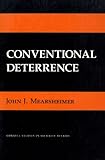Conventional Deterrence / John J. Mearsheimer.
Material type: TextSeries: Cornell Studies in Security AffairsPublisher: Ithaca, NY : Cornell University Press, [1985]Copyright date: ©1985Description: 1 online resource (296 p.)Content type:
TextSeries: Cornell Studies in Security AffairsPublisher: Ithaca, NY : Cornell University Press, [1985]Copyright date: ©1985Description: 1 online resource (296 p.)Content type: - 9781501713262
- Deterrence (Strategy) -- History -- 20th century
- Military history, Modern -- 20th century
- International Studies
- Political Science & Political History
- POLITICAL SCIENCE / Security (National & International)
- arms control
- book on arms control
- causes for war
- crises that lead to war
- deterrence and defense
- deterrence as a strategy
- explaining the causes of war
- game theory
- historical arms control
- international politics theory
- international security
- military deterrence
- military doctrine
- military history
- military science
- military strategies
- military strategy history
- military studies
- military theory
- modern military history
- political consideration for war
- political theory
- starting wars
- strategies of conflict
- study of world politics
- studying the military
- the causes of war
- theory of international politics
- war studies
- what are the origns of war
- what is conventional deterrence
- what is failed deterrence
- what starts wars
- why deterrence fails
- 355.02/17 23
- online - DeGruyter
| Item type | Current library | Call number | URL | Status | Notes | Barcode | |
|---|---|---|---|---|---|---|---|
 eBook
eBook
|
Biblioteca "Angelicum" Pont. Univ. S.Tommaso d'Aquino Nuvola online | online - DeGruyter (Browse shelf(Opens below)) | Online access | Not for loan (Accesso limitato) | Accesso per gli utenti autorizzati / Access for authorized users | (dgr)9781501713262 |
Frontmatter -- Contents -- Preface -- 1. Introduction -- 2. Conventional Deterrence -- 3. The Allied Decision Not to Attack Germany, March 1939-May 1940 -- 4. The German Decision to Attack in the West, 1939-1940 -- 5. Conventional Deterrence and the Arab-Israeli Conflict -- 6. The Prospects for Conventional Deterrence in Central Europe -- 7. Precision-Guided Munitions and Conventional Deterrence -- 8. Conclusion -- Notes -- Select Bibliography -- Index
restricted access online access with authorization star
http://purl.org/coar/access_right/c_16ec
Conventional Deterrence is a book about the origins of war. Why do nations faced with the prospect of large-scale conventional war opt for or against an offensive strategy? John J. Mearsheimer examines a number of crises that led to major conventional wars to explain why deterrence failed. He focuses first on Allied and German decision making in the years 1939–1940, analyzing why the Allies did not strike first against Germany after declaring war and, conversely, why the Germans did attack the West. Turning to the Middle East, he examines the differences in Israeli and Egyptian strategic doctrines prior to the start of the major conventional conflicts in that region. Mearsheimer then critically assays the relative strengths and weaknesses of NATO and the Warsaw Pact to determine the prospects for conventional deterrence in any future crisis. He is also concerned with examining such relatively technical issues as the impact of precision-guided munitions (PGM) on conventional deterrence and the debate over maneuver versus attrition warfare.Mearsheimer pays considerable attention to questions of military strategy and tactics. Challenging the claim that conventional detrrence is largely a function of the numerical balance of forces, he also takes issue with the school of thought that ascribes deterrence failures to the dominance of "offensive" weaponry. In addition to examining the military consideration underlying deterrence, he also analyzes the interaction between those military factors and the broader political considerations that move a nation to war.
Mode of access: Internet via World Wide Web.
In English.
Description based on online resource; title from PDF title page (publisher's Web site, viewed 26. Apr 2024)


